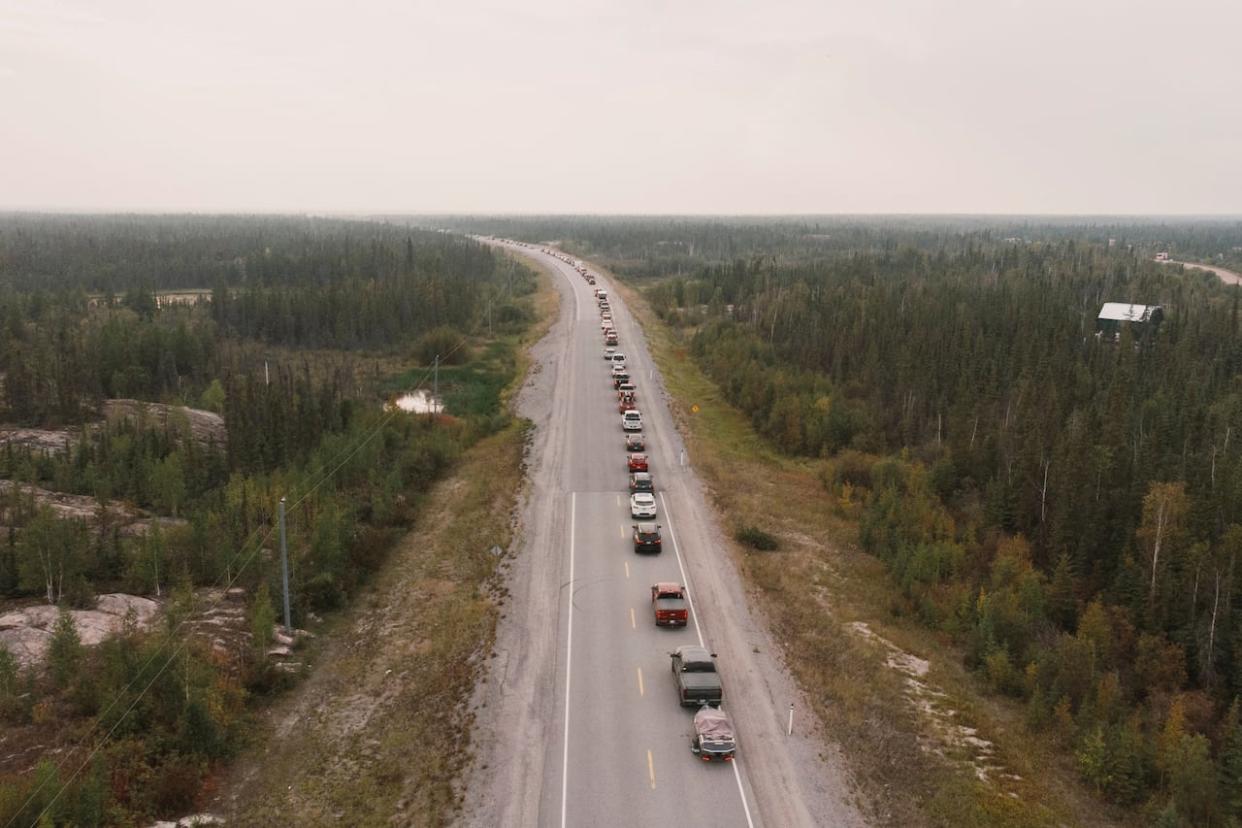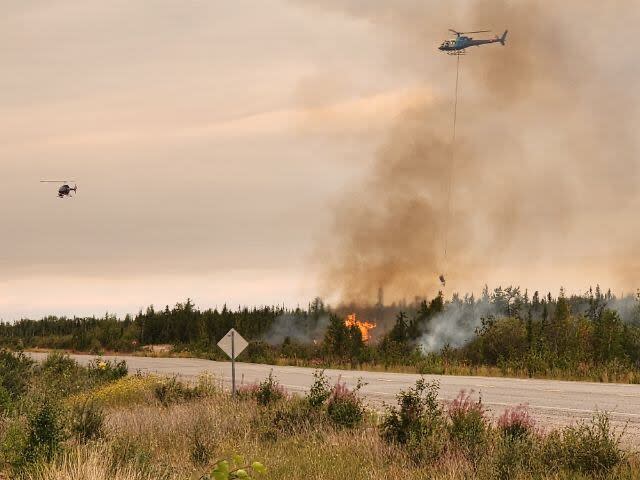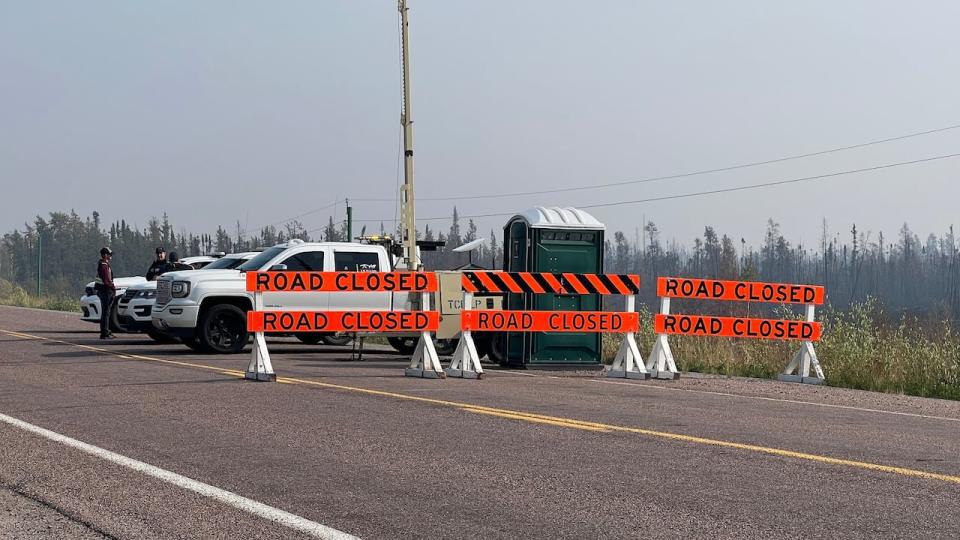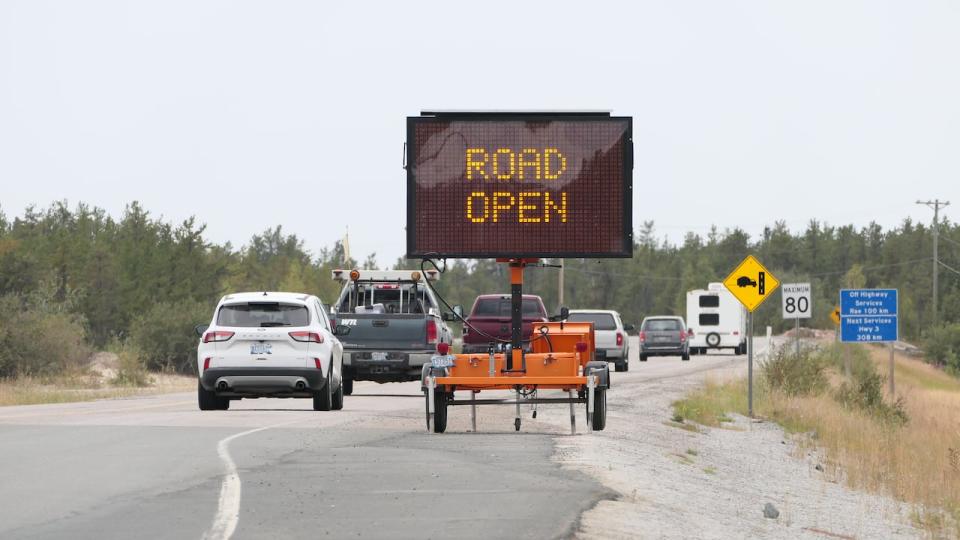Curious about logistics of getting home to Yellowknife? Here's what officials say

With the evacuation order for Yellowknife, Ndilǫ, Dettah and the Ingraham Trail set to lift at noon on Wednesday, government officials have been quick to urge people to think twice about when they want to come home, given the lack of services that will be immediately available, and to have a solid plan in place for the journey there.
CBC North asked people to send us their questions about the return plan. We'll update this as we get more answers.
Flying home
Q: How will the flights back to Yellowknife be organized?
The territory wants people to pre-register for flights back so they can develop a list of who needs a flight, and where they're currently staying. You can pre-register online, over the phone or by emailing a form.
Once they have flight information to share with you, they'll send it to you at least 24 hours before the flight, along with information about ground transportation to the airport.
You can bring two bags under 50 pounds, and your pets.
People who don't have ID, or who have expired IDs, will be allowed to travel on flights organized by the territory.
Q: For people who drove out but who don't have a ride back, are flights an option?
Yes. If you can't drive or catch a ride back, you can register for a flight.
Q: Are people who paid for their own flights out eligible to take a government flight home?
Yes. Jay Boast, spokesperson for the territorial emergency management organization, said in an email that those people can also pre-register for government-offered flights.
Q: What about people who ended up in smaller centres like Whitecourt?
You qualify for flights, but if you aren't staying in a so-called "flight hub", the territory's website says you'll be responsible for getting yourself to the closest evacuation or reception centre. Once there, you'll be shuttled to the airport.
On Saturday afternoon, James Fulford, incident commander with the Emergency Measures Organization, said they're working with Alberta to figure out where those hubs will be. He added that's a reason for people to register early, so authorities can figure out where everyone is.

Helicopters drop buckets of water on a flare-up along Highway 3 near Yellowknife on Aug. 27. (NWT Fire/Facebook)
Q: Once I've landed in Yellowknife, how do I get to my house?
Yellowknife city manager Sheila Bassi-Kellett said there will be lots of ground transportation to take people either directly to their homes or back to Sir John Franklin High School to pick up their vehicles. The Yellowknives Dene First Nation is also organizing buses to Dettah and Ndilǫ.
Bassi-Kellett said they are looking at the possibility of giving out taxi vouchers and providing ambulance support for people with mobility issues and they'll have more specifics available by the time flights roll around.
Q: When will commercial airlines be cleared to start flying back into Yellowknife?
Jeffrey Edison, the acting assistant deputy minister with the Department of Infrastructure, said Saturday that the priority right now is government flights to get everybody home. Still, commercial operations will start coming back online Wednesday at noon when the evacuation order lifts.
Edison said the department expects some commercial operations to be up and running that day, though services will be reduced.
Q: What if I wasn't in Yellowknife when the evacuation occurred? Should I plan to travel to an evacuation centre in Alberta to take a return charter flight, or wait for regularly scheduled flights to be reinstated?
You qualify for an N.W.T. re-entry flight, but you're responsible for getting yourself to an evacuation reception centre. Like other evacuees on the re-entry flights, after pre-registration, you will be assigned a flight and given at least 24 hours' notice of the details.
Driving home
Q: How will evacuees be supported on the drive home?
On Saturday afternoon, the territorial government said people returning by road will bear their own costs for accommodations, food and gas. The government's main support for people is a one-time $750 payment that has been critiqued for leaving many residents out in the cold.
The government will have portable washrooms around Fort Providence, the Deh Cho Bridge, North Arm Park and the Rae access road. Gas, which you will need to pay for, is available at three locations around Fort Providence: the Big River Service Centre, the Northern Store and the Snowshoe Inn. Drivers are being encouraged to bring extra gas if they can, but the territory said emergency gas will also be available.
There will also be increased police presence in northern Alberta and along the return route to enforce traffic laws, but also to check in and offer help to stranded drivers.

A blockade near Behchokǫ̀ on Highway 3. (Travis Burke/CBC)
Q: What do evacuees need to bring back with them?
Yellowknife Mayor Rebecca Alty is asking people to bring non-perishable food items to last 72 hours, if they can, to ease the burden on grocery stores in Yellowknife that won't be fully staffed right away.
Q: For those who can't drive the whole distance from Edmonton to Yellowknife in one day, how will overnight stops be handled?
You'll have to figure this out on your own.
Boast said Saturday that there are limited places available for overnight stays in High Level and Grande Prairie, since many South Slave evacuees are still in those communities, so people should plan carefully.
Travellers will be responsible for their own costs if they need to stay overnight.
Q: How will northern Alberta towns handle this return home, in terms of fuel, accommodations and food?
The response to this one also involves planning your trip carefully. For High Level, Edison noted the Alberta government is ready for 7,000-plus vehicles to come through High Level, where many will be stopping for gas and food at the very least.
High Level Mayor Crystal McAteer says businesses are preparing for swaths of travellers to continue coming through. She says that all of the town's 999 hotel rooms are booked but that there is an evacuation centre with 300 cots where evacuees can find respite.
"We'll just welcome them and provide them with some compassion and hope and comforts," McAteer said.
Further along the road, at the Big River Service Station outside Fort Providence, Edison said they've doubled the fuel capacity there, compared to what they had on-hand during the evacuation, so he isn't concerned about fuel.
Q: What is in place to ensure a safe, orderly re-entry so long lines of vehicles aren't stuck on Highway 1?
Boast said it's simply a reality that highways may close on short notice, given the wildfire situation. There could be some long delays, so check the highway conditions map as you go and know where you can stop for fuel or a rest.
One thing to take into account is that the Big River Service Station expects to be closed between midnight and 6 a.m.
If wildfires threaten highways, expect to run into delays at the border or at Steen River, according to Edison. The highway could be closed and barricaded. If that happens, highway workers will escort anyone who made it through before the closure to safety, while those who didn't make it in time will have to wait for the danger to pass.
Highway workers will also be along the Deh Cho Bridge to direct and manage traffic flow, in an effort to help cut down on congestion.

Evacuees leave Yellowknife in mid-August after an evacuation order. (Tyson Koschik/CBC)
Q: For some of us relying on insurance, our coverage ends when the evacuation order lifts. What about costs after that date?
Boast said the territorial government has arranged for accommodations to be extended to Sept. 8 (Friday) for those who need it.
They are also working on longer-term solutions for those who need to stay longer. He said details on an extension after Sept. 8 will be shared in the coming days.
How did we get here so fast?
Q: Which fire experts and territorial government departments were consulted prior to making the decision that Yellowknife was OK to return to?
At Saturday's press conference, Alty and city manager Sheila Bassi-Kellett said they've been working closely with the territorial government and the Yellowknives Dene First Nation on the re-entry plan.
Bassi-Kellett said one thing the city had sought clarity on is where the authority for the re-entry plan lay.
"MACA confirmed shortly after the evacuation that all aspects of the emergency, from planning to doing emergency response, these are the responsibility of the local government," she said.
"They ... made it clear that with advice from ECC and with their support, the timeline was up to the city as a local authority to determine."
Q: Why aren't they making people return in phases?
Technically, they are — it's just that one phase encompasses a vast amount of people.
Alty said the city started bringing back staff for critical services when they entered the third phase of their re-entry plan. Flights for health care workers are also ongoing.
On Monday and Tuesday, before the evacuation order lifts for the general public, other critical staff will be returning by road.
The mass return after Wednesday also excludes people who have certain health conditions or needs, who will be brought back at a later date.
Q: Why invite people back to Yellowknife before there has been time for health services to be set up beyond minimum?
The health system won't be back to full capacity for about a month, officials said Saturday.
Alty said it's about balancing the urgency to get people home with being fully staffed.
She said, "we can't wait a whole month for everything to get up and running and be perfect."
Q: Why weren't dental services included in the list of essential health care services that were recalled?
In an email, the City of Yellowknife said it had to weigh several factors in deciding which services to bring back immediately, including which ones were critical. It said there are a lot of important services that just couldn't be deemed critical.
It said the emergency department at Stanton could treat "acute dental conditions with basic medical interventions such as pain medications or antibiotics" during the evacuation.
"Anyone needing to see a dentist for urgent care would need to make their own travel arrangements (or work with their employer if they were an essential employee) to make their way to a community with dental services available," the city wrote.


